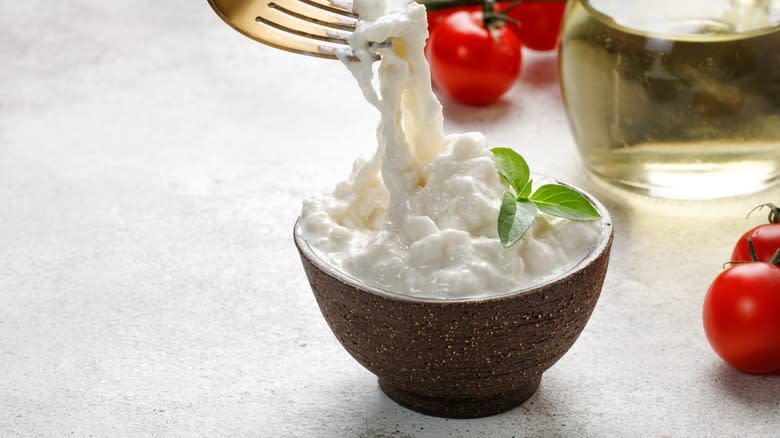The Absolute Best Way To Store Stracciatella Cheese

Creamy stracciatella cheese is a fresh cheese whose texture is a cross between stringy mozzarella and clumpier fresh ricotta, as the cheese is torn and shredded and combined with fresh cream. But all the moisture from the cream and the high-fat content makes stracciatella an obvious contender for easy spoilage. Like other high-quality fresh cheeses, you'll want to consume your stracciatella cheese as soon as possible, within a few days of opening.
But what's the best way to store stracciatella in the meantime? You'll want to provide the proper refrigeration conditions to make sure your stracciatella stays fresh until ready to use. And if you eat only some of the cheese and want to save the rest for later, you'll need a properly sealed, air-tight storage container to make it last a bit longer. Keep the cheese in the coldest section of your fridge to give it the best shot at staying fresh. Even though stracciatella cheese stores well at cold, refrigerated temperatures, do not store it in the freezer. You'll effectively ruin the texture and flatten the taste.
Read more: 11 Of The Best Cooking Tips From Bobby Flay
Store-Bought Versus Fresh Stracciatella Cheese

If you've purchased pre-packaged stracciatella cheese from a store, keep the cheese in its original air-tight tub and refrigerate until ready to eat. It should be safe to eat until the expiration date marked on the container, but will likely be at its best when consumed as soon as possible. Once the cheese is opened, you'll have to consume it within two days before the cheese starts going bad. For an opened container of stracciatella cheese, lay a piece of plastic wrap over the top of the container before re-sealing with the lid and placing it back in the fridge. The plastic wrap creates an extra barrier to keep the oxygen out and maintain the cheese's freshness.
If you've found some freshly made stracciatella at a specialty cheese shop, store it in an airtight container and consume it within the first two days of purchasing -- it'll start to spoil right away. As soon as the fresh stracciatella cheese is exposed to oxygen, bacteria growth is imminent. If you notice yellowing on the cheese's surface or smell any foul odors coming from the cheese, unfortunately, it's spoiling and is no longer safe to eat. Any mold growth is also an indication that you've waited too long and will have to throw the cheese away.
Ways To Enjoy Stracciatella Cheese

Before enjoying your stracciatella cheese, make sure to bring it to room temperature before serving. About 15 minutes outside of the fridge should be enough -- you don't want to leave it out for too long and have it spoil. This will help bring stracciatella's mild and slightly sour flavors to the forefront.
You may have enjoyed stracciatella in a ball of fried burrata, as burrata is simply stracciatella cheese wrapped in a thin layer of mozzarella. But it's equally as enjoyable and multi-purpose on its own. Stracciatella is one underrated cheese to put on top of homemade pizza, going beyond the usual grated parmesan -- but add it after your pizza is done because you don't want to cook the cheese on top. You can also add stracciatella to your favorite pasta dishes like pasta pomodoro or bolognese, or even incorporate it into homemade mac and cheese. Even a snack as simple as a crusty baguette slice topped with some stracciatella cheese and a drizzle of olive oil can be heaven.
It's not advisable to cook stracciatella or other fresh cheeses, so simply adding it as a topping onto a variety of dishes is best. However you choose to enjoy stracciatella, make sure to eat it as fresh as possible, and you'll be craving this creamy, stretchy fresh cheese over and over again.
Read the original article on Daily Meal.

